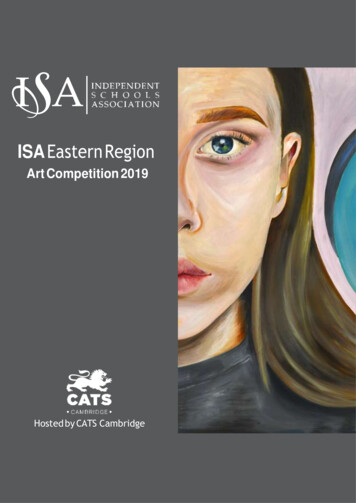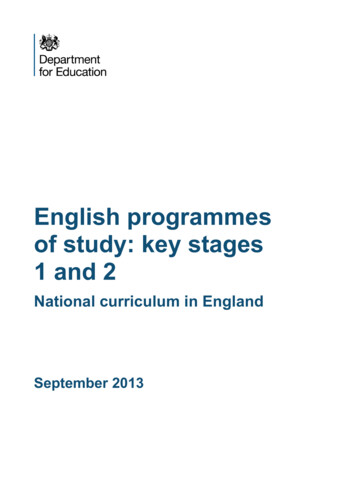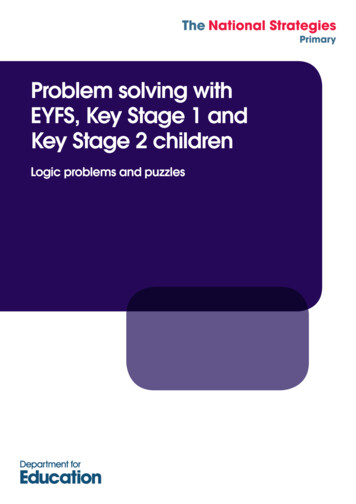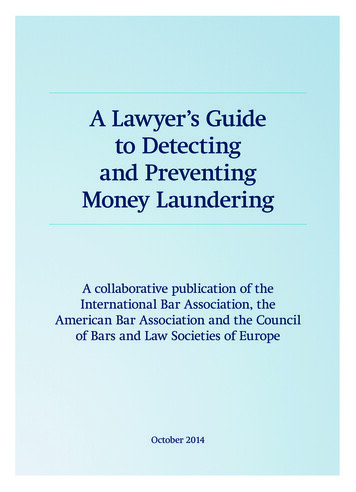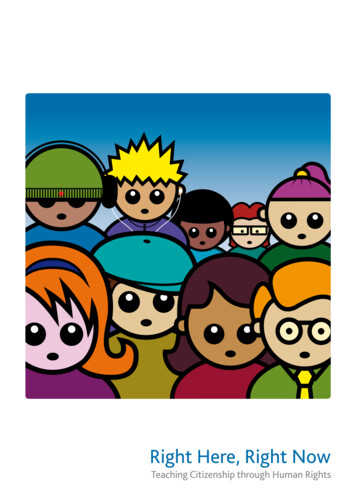
Transcription
A resource for key stage 3 citizenship teachers in England
AcknowledgementsThis resource is part of a project which is a partnership between the Ministry of Justice (MoJ)and the British Institute of Human Rights (BIHR) and involving Amnesty International and theDepartment for Children, Schools and Families (DCSF). Special thanks must go to the followingpeople for their support in the development of this resource:Alec Roberts – Portchester Community SchoolJeremy CunninghamAnn-Marie Sheridan, Dan Jones, Isobel Mitchell, JoCobley, Laura Morris, Maggie Paterson, Richard Riddell,Tim Hancock, Veronica Raymond and StanchesterCommunity School Amnesty Group –Amnesty International UKJo Robinson – Kingsbury High SchoolJohan Jensen – StonewallJohn Lloyd and Andrew Baxter –Department for Children, Schools and FamiliesKate Armstrong and Anne McNulty –Central Foundation Girls’ SchoolAnna Strhan – Latymer Upper SchoolBalbir Sohal – Coventry City CouncilLee Faith – Deptford Green SchoolBecky Downes – The Kingswinford SchoolLiz Craft – The Qualifications and Curriculum AuthorityCarla Garnelas and Carolyne Willow –Children’s Rights Alliance for EnglandLorna Robins, Sheila Bloom and Philip Doyle –The Institute for Global EthicsCarole Whitty – National Association of Head TeachersMark Rusling and Natalie Samarasinghe – UNA-UKCatriona Maclay – Salisbury schoolMatthew Burfield – Lambeth AcademyAmy Barrick, Ceri Goddard, Kat Clavell-Bate, KatieGhose, Lucy Matthews, Hannah Clayton, Helen Trivers,Roisin Cavanagh, Sonya Sceats and Ursula Lumley –The British Institute of Human RightsMichael McCann – Addington High SchoolNicholle Lennon and Clare Bridgewater –City of London AcademyChris Waller and Millicent Scott –The Association for Citizenship TeachingPaul Buddery – 11 MillionClaire Glover – Littlemoss High SchoolRuth Owen – Eastbury SchoolDeepika Taylor – Skinners’ Company’s School for GirlsSam Nicholson – The Citizenship FoundationDon Harrison – Bath Spa UniversitySarah Brown –The English Secondary Students’ AssociationRachel Heilbron and Ruth Crawford – Save the ChildrenDonna Snaith, Glenn Preston and Paul Zimmermann– Ministry of JusticeScott Harrison – OfstedEdward Waller – UNICEFSequoia Tailor – St Paul’s RC HighFiona Booth and Michael Raftery – The Hansard SocietySteve Newman – Hylton Red House Secondary SchoolGillian Windass – The National Governors AssociationLesson 1Adapted from a lesson by Michael McCannHilary Chamberlain – Parentline PlusLessons 5, 10 and 11 Written by the Children’s Rights Alliance for EnglandHugh Starkey and Sam Mejias –The Institute of Education, University of LondonDesigned by Darren Poole – Ministry of JusticeIan Massey – Hampshire County CouncilJan Courtney – Gloucestershire County CouncilJanine Young and Ellie Munro –National Children’s BureauRight Here, Right Now Acknowledgements Teaching Citizenship through Human Rights
Foreword“Where, after all, do universal human rights begin? In small places, close to home - so close and sosmall that they cannot be seen on any maps of the world. Yet they are the world of the individualperson; the neighborhood he lives in; the school or college he attends; the factory, farm, or officewhere he works. Such are the places where every man, woman, and child seeks equal justice, equalopportunity, equal dignity without discrimination. Unless these rights have meaning there, they havelittle meaning anywhere. Without concerted citizen action to uphold them close to home, we shall lookin vain for progress in the larger world.”Eleanor RooseveltRight Here, Right Now: Teaching citizenship throughHuman Rights is a unique resource and part of apackage of education materials, including a bookletoffering guidance on putting human rights at theheart of school life; its ethos and culture, policies andpractice.Giving young people the chance to learn abouttheir human rights and the rights of those aroundthem is a vital part of building a wider culture ofhuman rights in England. Ensuring everyone within aschool understands their rights and how to protectthem brings home to the individual the importanceof respecting the rights of everyone in a schoolenvironment: students, teachers and other staff,families and carers.The pack aims to link the concepts of universal humanrights with everyday experience, focusing on whathuman rights mean for young people in England. It isintended to help teachers to bring human rights to life,enabling them to explore with students concrete issuessuch as poverty and discrimination and to facilitatechallenging debates about identities, diversity andrights and responsibilities.We hope that this proves to be an excellent resourcefor citizenship lessons and beyond - stimulating freshdiscussion, debate and action on human rights that allcan learn from.Ministry of JusticeBritish Institute of Human RightsDepartment for Children, Schools and FamiliesAmnesty International UKRight Here, Right Now Foreword Teaching Citizenship through Human Rights
ContentsIntroduction5Background informationPart 1 – An introduction to human rights7Part 2 – Human rights education13Module overview and curriculum links17Lesson Plans and ResourcesRight Here, Right Now ContentsLesson 1School rules!21Lesson 2The human rights story28Lesson 3Human rights in focus36Lesson 4Human rights in the UK46Lesson 5The United Nations Convention on the Rights of the Child54Lesson 6Balancing rights63Lesson 7Taking responsibility for human rights76Lesson 8Human rights issues: Identities, diversity and common values81Lesson 9Human rights issues: Homophobic bullying87Lesson 10Human rights issues: Focus on participation94Lesson 11Human rights issues: Child poverty100Lesson 12Taking action for human rights109Assessment levels119The UK Human Rights Act121The Universal Declaration of Human Rights125Glossary128Further information130Feedback form131 Teaching Citizenship through Human Rights
Introduction“It has long been recognized that an essential element in protecting human rights was a widespreadknowledge among the population of what their rights are and how they can be defended.”Boutros Boutros-Ghali, Sixth UN Secretary-General, 1992–1996About this resourceBackground to the resourceHuman rights belong to everyone; knowing what theserights are and how they relate to our own lives is a firststep towards a culture where everyone’s human rightsare routinely respected. This resource is for all teacherswho want to explore with their students the role ofhuman rights in our day to day lives in the UK, anddemonstrate a human rights approach in their work.When the Human Rights Act came into force in 2000,its wider aim was to create a culture of respect forhuman rights here in the UK. The Department forConstitutional Affairs (now the Ministry of Justice)commissioned research into what they could do tosupport young people to contribute to this culture ofhuman rights, which resulted in the ‘Human Rights inSchools’ project. The project is based on the premisethat young people will benefit from being taughtabout human rights, and will learn about rights mosteffectively within a school environment where humanrights are promoted and respected.Resource aimsThe resource aims to facilitate effective teaching andlearning of human rights within KS3 Citizenship by: supporting teachers to feel confident deliveringlessons on human rightsThe project consists of three elements: This teaching resource for KS3 Citizenship enabling students to learn about the concepts andvalues of human rights and think about how theyare relevant to their lives A programme of teacher training on human rights Guidelines for secondary schools on how to developa whole-school approach to human rights. enabling students to learn about the Human RightsAct 1998 and the United Nations Convention onthe Rights of the Child, two of the most importanthuman rights measures for children and youngpeople in the UK supporting students to use human rights as aframework for exploring topical and controversialissues such as homophobia and child poverty supporting the development of key citizenship skillsby empowering students to take action to upholdand promote human rights encouraging a human rights approach to subjectdelivery.Right Here, Right Now Introduction Teaching Citizenship through Human Rights
How to use the resource Use exploring human rights lessons to cover keyhuman rights concepts and values, then comeback to the issue based lessons throughout the keystage - encouraging students to use a human rightsapproach to these issues.This resource is designed to support the delivery of therevised KS3 Citizenship curriculum to be taught fromSeptember 2008. The new curriculum is underpinnedby three key concepts: Use some activities from the exploring human rightssection to familiarise students with human rightsin order to move straight to the human rights issueslessons. Democracy and Justice Rights and Responsibilities Identities and Diversity: living together in the UK.Whilst this resource is rooted in the key concept ofRights and Responsibilities, human rights also underpinthe other key concepts of Democracy and Justice, andIdentities and Diversity. Human rights education canbe a valuable approach to the teaching of all threeconcepts. Use the lesson plans as part of a suspendedtimetable day on human rights.The resource contains comprehensive backgroundinformation and a series of twelve lesson plans withaccompanying worksheets and resource sheets. Thelessons are divided into three sections:Assessment opportunitiesThis resource is just a starting point and can be addedto and adapted to suit the needs and context of yourstudents and school.This resource offers suggestions for assessment forlearning throughout the resource and also containssuggested Mid-Unit and End of Unit summativeassessment activities. Assessment opportunities areflagged at the beginning of each lesson plan. Lessons 1–7: Exploring human rights – In this sectionstudents will explore key human rights conceptsand values, how these are expressed in the HumanRights Act and the United Nations Convention onthe Rights of the Child, and learn about upholdinghuman rights in our personal lives, and as part of aschool, local and global community.At Key Stage 3, Citizenship is now in line with othersubjects in that teachers are required to judge studentattainment in citizenship using level descriptions.These are set out as an eight level scale and providea guide to the expected standards of attainment forcitizenship. Assessment using the level descriptionsbecomes statutory from summer of 2011 for studentscompleting key stage 31. The level descriptionsreference conceptual understanding and skills studentsshould develop in citizenship as set out in the revisednational curriculum programme of study for citizenship.Activities that can be used for assessment have beendeveloped for the mid-unit and end of unit activities.The assessment/success criteria indicate how toidentify learning and progression within specificknowledge and skills relevant to each activity. Lessons 8–11: Human rights issues – In this sectionstudents will explore relevant domestic issuesincluding homophobia, identities and diversity,participation, and child poverty from a human rightsperspective. Lesson 12: Taking action for human rights – In thissection students will plan to take action on a humanrights issue, using their knowledge and skills fortaking responsibility and action. Students andteachers may choose to use this as the start of anactive citizenship project.Characteristics of progression in knowledge,understanding and skills in relation to human rightseducation have been provided at the end of theresource. These may be helpful in devising otherassessment activities to accompany this resource.The lessons have been designed to flow as a scheme oflearning, but they can be used in various ways to suitthe way citizenship is delivered in your school: Use exploring human rights lessons to cover keyhuman rights concepts and values, then move tosection three to support students to develop anactive citizenship project based on human rights.1 The eight level scale for citizenship can be found on the QCA’s New Curriculum website http://curriculum.qca.org.ukRight Here, Right Now Contents Teaching Citizenship through Human Rights
Background informationPart 1 – An introduction to human rights1. Background and history ofhuman rightsThe international community has agreed severalkey characteristics of human rights2: Human rights are UNIVERSAL – they belong toeverybody in the worldWhat are human rights? Human rights are INALIENABLE – they cannotbe taken away from people‘Human rights are what no one can take awayfrom you.’ Human rights are INDIVISIBLE andINTERDEPENDENT – all the different humanrights are important for human beings toflourish and participate in societyRene CassinOne of the principal drafters of the UniversalDeclaration of Human RightsHuman rights are the basic rights we all have simplybecause we are human; they are the fundamentalthings that human beings need in order to flourishand participate fully in society. Human rights belongto everyone, regardless of their circumstances. Theycannot be given away or taken away from you byanybody, although some rights can be limited orrestricted in certain circumstances. For example, yourright to liberty can be restricted if you are convictedof a crime. They primarily regulate the relationshipbetween the state and individuals.Where do human rights come from?‘Human rights are inscribed in the hearts ofpeople; they were there long before lawmakersdrafted their first proclamation.’Mary RobinsonFormer United Nations High Commissioner forHuman RightsThe ideas behind human rights have been presentthroughout history in many different societies andcivilisations3. The modern concept of human rightsemerged in the 20th century as a response to the eventsof the Second World War, in particular the Holocaust.This appalling abuse of human dignity and disrespectfor human life led states to come together in 1948under the United Nations (UN) to agree the UniversalDeclaration of Human Rights (UDHR) – perhaps themost famous and important human rights document.Human rights are underpinned by a set of commonvalues, including fairness, respect, equality, dignity andautonomy. Human rights declarations, conventions andlaws are the starting point for making these values realin people’s lives.There are many different human rights, reflecting ourbasic needs across different areas of our lives. Civiland political rights include the right to liberty andthe right to freedom of expression, while economic,social and cultural rights include the right to thehighest attainable standard of health and the right toeducation.The Universal Declaration of Human RightsIn 1947 the UN established the Human RightsCommission, chaired by Eleanor Roosevelt, to draft theUDHR. Representatives from a range of countries wereinvolved in the drafting process, the text was consideredat a great number of meetings of the UN GeneralAssembly, and the Declaration was adopted by the UNon 10 December 1948.2 Vienna Declaration and Programme of Action 19933 See the human rights timeline in lesson 2 for more informationRight Here, Right Now Background information Teaching Citizenship through Human Rights
The preamble to the UDHR sets out the aims of theDeclaration, namely to contribute to ‘freedom, justiceand peace in the world’, to be achieved by universalrecognition and respect for human rights. These rightsare then defined in 30 articles which include civil,political, economic, social and cultural rights. The Convention Against TortureThe main innovation of the UDHR is that it recognisesfor the first time a universal entitlement to rightsapplying to ‘all members of the human family’. Beforethis the rights and freedoms of individuals wereregarded as the domestic affair of the state withinwhose jurisdiction they fell. The traumatic events ofthe Second World War prompted the strong belief thatthis situation was no longer tenable, that universalprotection was needed for all people, and that theinternational community should monitor more stronglywhat was happening inside states. The United Nations Convention on the Rights ofthe Child The Convention on the Elimination of DiscriminationAgainst Women The Convention on the Elimination of RacialDiscrimination The Convention on the Rights of Persons withDisabilities.The international human rights treaties are not partof the UK’s domestic law. This means that you cannotbring a case against the government using one ofthese treaties in the UK courts. However, the UK hassigned up to a mechanism under the Convention on theElimination of Discrimination against Women whichallows individual women in the UK to make complaintsto a committee of experts at the UN if they believetheir rights have been violated.Human rights lawsWhile all of the above treaties are relevant to schools,the most important international treaty for teachers toknow about is the UNCRC. This will be explained furtherin the next section.There are three different levels of human rightslaw – international, regional and domestic. Theseare enforced and monitored in different ways.International lawRegional lawThe UDHR is a declaration, and is not legally binding.However it has prompted and inspired a rangeof international human rights laws (often calledconventions, covenants or treaties), such as theInternational Covenant on Civil and Political Rights,the United Nations Convention on the Rights ofthe Child (UNCRC), and the Convention againstTorture. These are enforced and monitored by theUnited Nations. Countries that agree to be bound bythese have to submit regular reports (usually every4–5 years) to show how they are implementing therights in the treaty. The reports are examined by acommittee of experts, which publishes its concerns andrecommendations.At the same time that human rights were beingdeveloped within the UN system, regional groups ofstates started adopting home-grown treaties dealingwith human rights. These include the EuropeanConvention on Human Rights, the African Charteron Human and Peoples’ Rights, and the AmericanConvention on Human Rights. The EuropeanConvention on Human Rights is arguably the mostdeveloped of these regional mechanisms. TheConvention was agreed after the Second World War bythe Council of Europe, which was set up to safeguardand defend human rights, democracy and the rule oflaw across its member states. The Council of Europeis not to be confused with the European Union. TheCouncil of Europe represents ‘Greater Europe’ andcurrently has 47 member states including countriessuch as Russia, Turkey and the Ukraine. The Conventionestablished a European Court of Human Rights based inStrasbourg, France.The UK has signed up to the following core humanrights treaties4: The International Covenant on Civil and PoliticalRights The International Covenant on Economic, Social andCultural Rights4 If you would like to find more information on any of these treaties, please see the website of the Office of the High Commissioner for Human Rights:www.ohchr.orgRight Here, Right Now Background information Teaching Citizenship through Human Rights
The United Nations Convention on theRights of the ChildThe UK signed the European Convention on HumanRights in 1951; UK lawyers had been instrumental inthe drafting process. Anyone in the UK can complain tothe European Court of Human Rights if they think theirrights set out in the Convention have been breached.Now that the Human Rights Act has come into force(see below) human rights cases under the Conventioncan be heard in the UK courts, without having to go allthe way to Strasbourg. The European Court will onlyhear cases once they have gone through all possible UKcourts.Children are entitled to all human rights, howeverthere is a dedicated human rights document forchildren called the UNCRC. The UNCRC was openedfor signature in 1989 and has been ratified by all UNmember states except the United States and Somalia,making it the most widely ratified international humanrights treaty. The UK Government ratified the UNCRCin 1991.The Convention has 54 articles, or parts, 40 of whichgrant children (aged under 18) a comprehensive setof human rights. The particular needs of children hadbeen recognised earlier in the UDHR (1948), whichstates that childhood is entitled to ‘special care andassistance’. However, the UNCRC was necessary forfour main reasons:Domestic lawMany countries also have their own domestic humanrights legislation. In the UK, we have our own HumanRights Act which came into force on 2 October 2000.The Human Rights Act allows people to use certainrights drawn from the European Convention on HumanRights in our domestic courts. More information on theHuman Rights Act can be found below.1 Childhood is a period of unparalleled growth,development and potential;2 Children, especially infants and very young children,are easy to hurt and harm, intimidate and frighten– they are vulnerable and need protection;2. Key human rights documentsHuman rights are universal. They apply across theworld and belong to everyone. As you have read, thereis a range of different declarations and conventionsthat aim to protect human rights in the UK, Europe andthe World. However this resource focuses on humanrights in the UK. The main conventions and laws thatteachers must know about in order to confidently usethis resource are the UNCRC, an international humanrights treaty, and the Human Rights Act which is partof our domestic law in the UK. These are the mostrelevant to children and young people in the UK, andto those working with children and young people inpublic bodies in the UK. They are a foundation forlearning about and using other treaties which may be ofrelevance to young people, such as the Convention onthe Elimination of Discrimination Against Women, theConvention on the Elimination of Racial Discrimination,and the Convention on the Rights of Persons withDisabilities.Right Here, Right Now Background information3 Children’s needs and interests are often ignored ordownplayed in public debates and decision making;4 A dedicated treaty gives a focal point and legalframework for all those seeking to improve children’slives and social status – in all parts of the world.The concept of the ‘best interests of the child’ isparamount in the interpretation and implementation ofthe Convention.One of the most innovative and vital aspects of theUNCRC is its emphasis on children being heard andtaken seriously. Article 12 of the Convention gives everychild the right to express their views on any matter thataffects them. There is no minimum age requirementfor this right. Indeed, the United Nations Committeeon the Rights of the Child has issued guidelines forgovernments on how they must protect the rights ofyoung children – these guidelines stress the absoluteimportance of listening to babies and young children.The views of children must be given due weightaccording to their age and maturity – in other words,the more a child understands a particular decision, andthe consequences of their views, the more influencetheir views will have. Article 12 specifically requires thatin any decision-making forum – a court proceeding orschool exclusion hearing for example – the child’s viewsmust be heard directly or through a representative. Oneof the central aspects of children’s human rights is that Teaching Citizenship through Human Rights
children must be respected as people today, and notseen and treated simply as ‘people-in-the-making’. Ifadults focus exclusively on the future – what a child will(or should) become – they can miss out on who the childis today. Children’s right to be heard and taken seriouslyis increasingly part of domestic law, particularlyrelating to children in contact with social care services.The Education and Inspections Act 2006 introduceda requirement for schools in England and Wales toconsult students on the development of new behaviourpolicies and legislation has since 2002 required schoolsto have regard to student participation guidance.‘[A culture of respect for human rights wouldexist when] there is a widely-shared senseof entitlement to these rights, of personalresponsibility and of respect for the rightsof others, and when this influence[s] all ourinstitutional policies and practices.’Joint Committee on Human RightsUK ParliamentThe Human Rights Act has a real application in oureveryday lives in the UK. It has been used to protectolder people who are being abused in care homes,to ensure that disabled children are provided withtransport to get to school, and to protect womenfrom domestic violence. The significance of theHuman Rights Act is not restricted to decisions aboutindividuals; it has been used to support policy-makingand practice at an institutional level and can be appliedto broader areas of society such as civic participation,involvement and community development.The United Nations Committee on the Rights of theChild, a body of 18 children’s rights experts whichmeets in Geneva three times a year, monitors theimplementation of the UNCRC in each country of theworld. It examines each State Party (country that hasratified the Convention) every five years. You can readthe UK Government’s most recent report (includinga version written especially for children and youngpeople) on the implementation of the UNCRC atwww.everychildmatters.gov.uk/uncrc/ and you canread the reports on the UK written by the Committeeon the Rights of the Child at www2.ohchr.org/english/bodies/crc/index.htm. The Committee on the Rights ofthe Child also hears evidence from non-governmentalorganisations (NGOs) and children and young people;you can find out more about the process in England byvisiting the following websites:The rights contained in the Human Rights Act The right to life The right not to be tortured or treated in aninhuman or degrading way The right to be free from slavery or forced labour The right to www.unicef.org.uk The right to a fair trial The right to no punishment without lawThe Human Rights Act The right to respect for private and family life,home and correspondenceThe UK Government introduced The Human Rights Act1998 with two main aims: The right to freedom of thought, conscience andreligion1 To bring the human rights contained in the EuropeanConvention on Human Rights into UK law. Thismakes it possible for people to raise or claim theirhuman rights within complaints and legal systemsin the UK. The Human Rights Act therefore makeshuman rights more accessible – it is generallyquicker, cheaper and more practical to bring yourcase before the UK courts. The right to freedom of expression The right to freedom of assembly and association The right to marry and found a family The right not to be discriminated against in relationto any of the rights contained in the EuropeanConvention on Human Rights2 To bring about a new culture of respect for humanrights in the UK. Human rights are not just about thelaw and taking cases to court. They are relevant tomany of the decisions people make and the situationspeople experience on a daily basis. The governmentintended the Human Rights Act to place human rightsat the heart of the way public services are delivered.Right Here, Right Now Background information The right to peaceful enjoyment of possessions The right to education The right to free elections Abolition of the death penalty.10Teaching Citizenship through Human Rights
inequality, eliminate discrimination, strengthen goodrelations between people and to promote and protecthuman rights. It has a statutory responsibility forpromoting the importance of human rights and theHuman Rights Act, and will encourage good practicewithin public authorities to respect human rights aswell as providing advice, guidance and support to otherorganisations (voluntary and community organisations;businesses) and to individuals.How the Human Rights Act worksThe Human Rights Act works in four main ways:1 All public authorities in the UK, including stateschools, must respect the rights contained in theHuman Rights Act in everything that they do. Publicauthorities are not just under a duty not to commithuman rights abuses – sometimes public authoritieshave to take proactive steps in order to ensure thathuman rights are respected, protected and fulfilled.3. Balancing different Human RightsWhat is a public authority?The classification of rights‘Public authority’ is not fully defined in the HumanRights Act, but it should be interpreted broadly.It includes all central Government departmentsand local authorities, as well as state schools, NHSTrusts, prisons, the police, courts and tribunals.Not all the rights in the Human Rights Act are of thesame type. Some are ‘absolute’ rights, which meansthey can never be interfered with by the state, whileothers are non-absolute – they can be interfered with incertain circumstances.There are three main types of rights:2 Anyone who believes that their rights have beenbreached by a public authority can bring a claimagainst the public authority. This can be in theordinary UK Courts, and in a range of other systemsand processes including tribunals, hearings andcomplaints procedures. Anyone in the UK can bringa claim under the Human Rights Act – the Act is notlimited to UK citizens.Absolute rights cannot be interfered with or limited inany way. Examples of absolute rights are the right notto be tortured or treated in an inhuman or degradingway and the right not to be enslaved.Limited rights can be limited in specific circumstances,which are set out in the Human Rights Act. An exampleof a limited right is the right to liberty, which can belimited in certain cases, for example, where someon
Right Here, Right Now _ Introduction Teaching Citizenship through Human Rights Introduction “It has long been recognized that an essential element in protecting human rights was a widespread knowledge among the population of what their rights are and how they can be defended.” Bou


